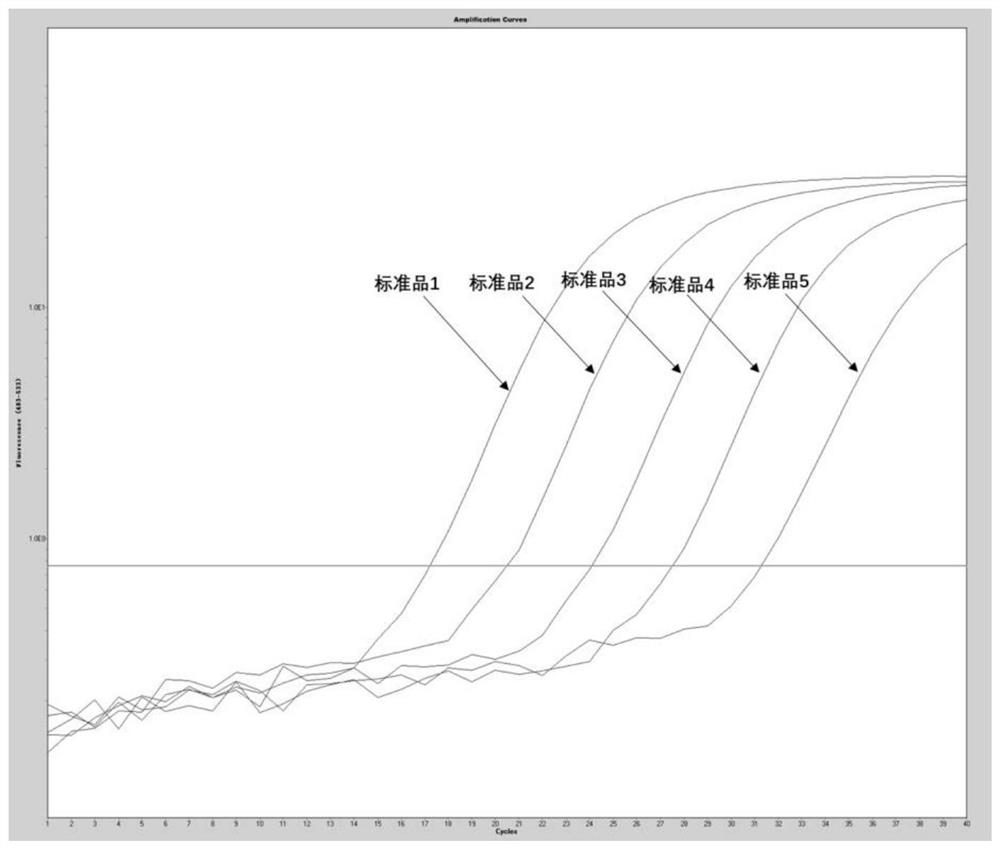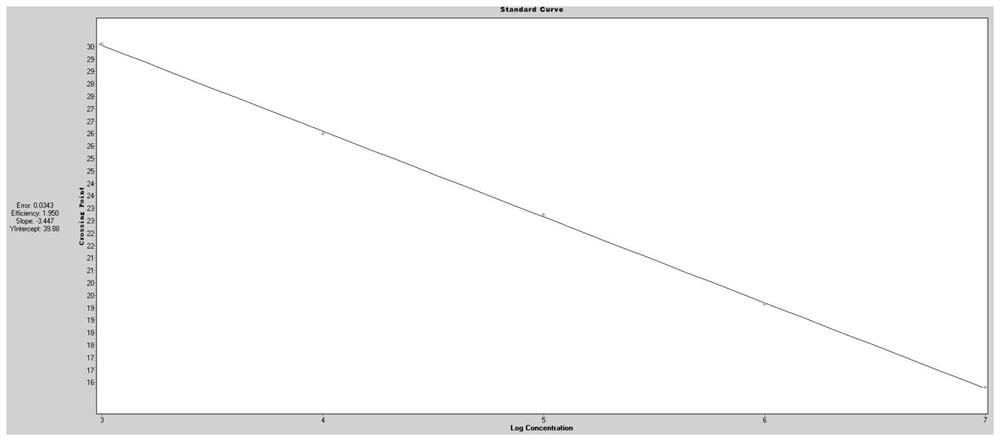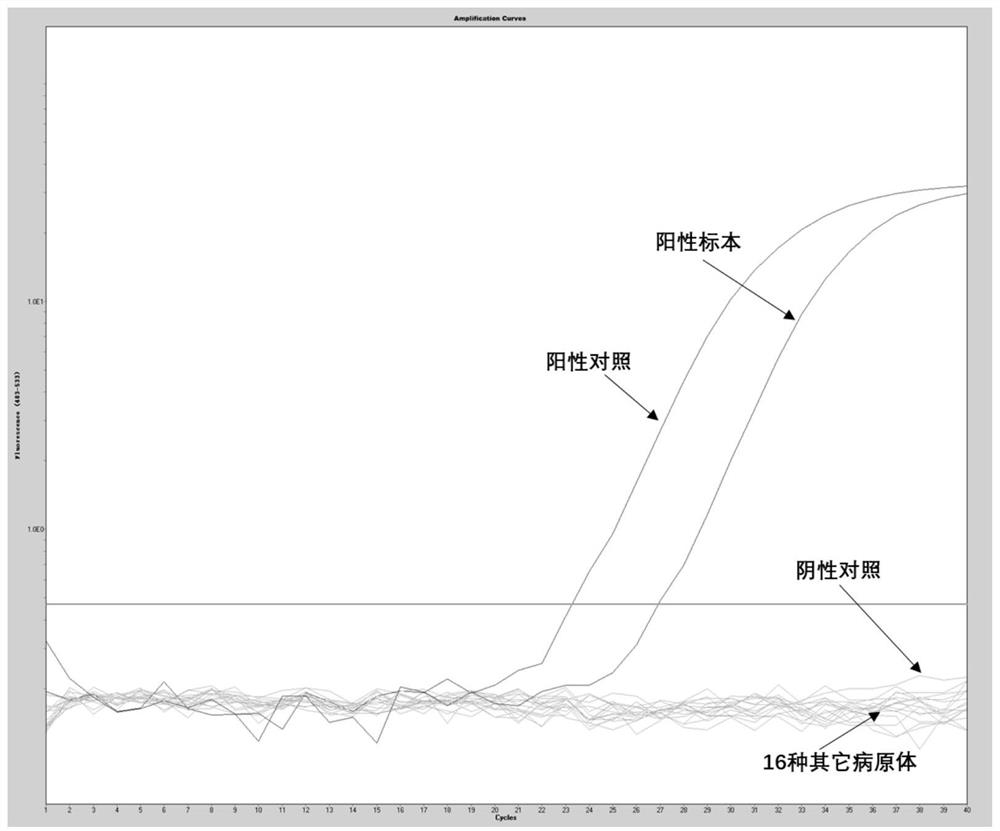A method and application of Taqman probe fluorescent quantitative PCR to detect Bartonella
A real-time fluorescence quantification and probe technology, which is applied in microorganism-based methods, biochemical equipment and methods, and microbial determination/inspection, etc. Efficient amplification and easy result determination
- Summary
- Abstract
- Description
- Claims
- Application Information
AI Technical Summary
Problems solved by technology
Method used
Image
Examples
Embodiment 1
[0029] The real-time fluorescent quantitative PCR of embodiment 1 Bartonella detects the design and screening of primer pair and probe
[0030] 1. Using the Blastn local comparison software, the nucleic acid sequence of Bartonella was analyzed and compared with nucleic acids of other pathogens to find a specific diagnostic target for Bartonella. Using Primer Express 3.0 design software, fluorescent quantitative primers and Probes, synthesized by the company. The Roche LightCycler96 real-time fluorescent quantitative PCR instrument was used to monitor the real-time situation in the quantitative PCR process, and to analyze the melting curves, take-off time, amplification efficiency, and the time required to reach the plateau of different primers and probe test groups. A set of fluorescent quantitative PCR primer pairs and probes with the highest amplification efficiency and the best specificity were screened out, and the sequences are shown in Table 1.
[0031] Table 1
[0032...
Embodiment 2
[0033] Real-time fluorescent PCR kit and detection method of embodiment 2 Bartonella
[0034] 1. The composition of the kit
[0035] This kit includes a pair of specific primers for Bartonella (as shown in Table 1), a specific fluorescent probe (as shown in Table 1), positive control, negative control, 5×PCR Buffer and Enzyme Mix;
[0036] (1) A pair of specific primers for Bartonella (upstream primers and downstream primers are shown in Table 1)
[0037] (2) A specific fluorescent probe of Bartonella (as shown in Table 1)
[0038] In this embodiment, the 5' end of the fluorescent probe is labeled with the fluorescent reporter group FAM, and the 3' end is labeled with the fluorescent quencher group BQ1; in other embodiments, other fluorescent reporter groups and other fluorescent quencher groups can also be selected. Specifically, the fluorescent reporter group can also be replaced by VIC, HEX, TRT, Cy3, Cy5, ROX, JOE and Texas Red, and the fluorescent quencher group can als...
Embodiment 3
[0072] The specificity test of embodiment 3 Bartonella fluorescent quantitative PCR amplification
[0073] The samples used in the specificity test of the Bartonella real-time fluorescent quantitative PCR detection method have other positive strains or positive samples. After fluorescent quantitative PCR amplification, the results showed that only the Bartonella positive specimens and positive controls had amplification curves, and the other 16 pathogens and negative controls had no amplification curves ( image 3 ), see Table 1 for details. This result shows that the detection method has good specificity.
[0074] Table 1 specificity analysis of the present invention
[0075]
[0076]
PUM
| Property | Measurement | Unit |
|---|---|---|
| Sensitivity | aaaaa | aaaaa |
Abstract
Description
Claims
Application Information
 Login to View More
Login to View More - R&D
- Intellectual Property
- Life Sciences
- Materials
- Tech Scout
- Unparalleled Data Quality
- Higher Quality Content
- 60% Fewer Hallucinations
Browse by: Latest US Patents, China's latest patents, Technical Efficacy Thesaurus, Application Domain, Technology Topic, Popular Technical Reports.
© 2025 PatSnap. All rights reserved.Legal|Privacy policy|Modern Slavery Act Transparency Statement|Sitemap|About US| Contact US: help@patsnap.com



